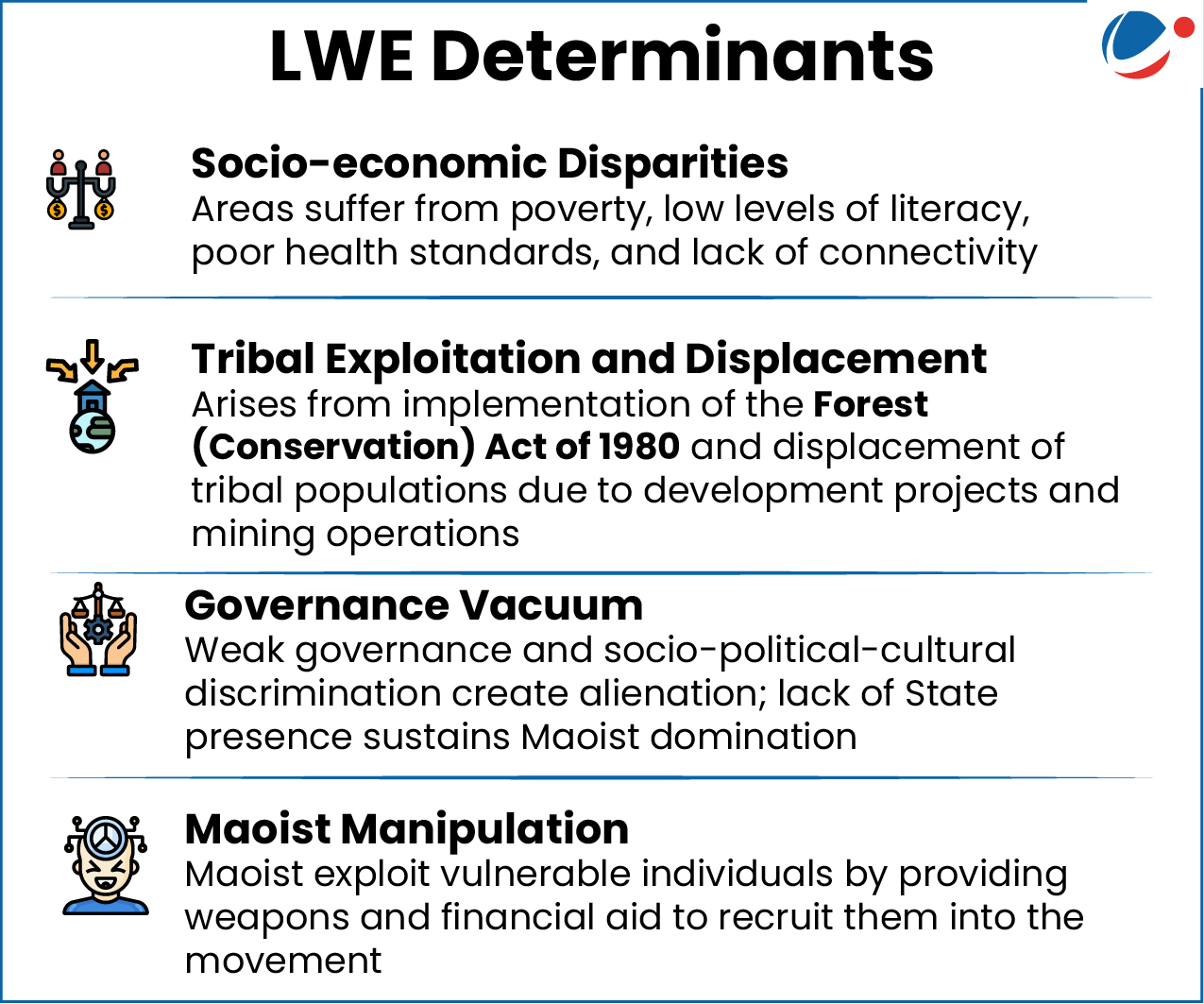
Why in the News?
The Ministry of Home Affairs (MHA) has informed that the number of most affected districts reduced from 6 to three (Bijapur, Sukma, Narayanpur- all in Chhattisgarh).
More on the News
- State achievements: Andhra Pradesh and Telangana have recently been delisted from the category of LWE-affected states.
- Government Target: Complete elimination of Naxalism by March 31, 2026.
- The overall number of LWE-affected districts has reduced from 18 to 11.
About LWE
- LWE, commonly referred to as Naxalism, is one of India's most serious internal security challenges.
- Ideology: It is rooted in socio-economic inequalities and fueled by Maoist ideology, utilizing violence and propaganda to overthrow the existing democratic government and establish a classless society.
- Region affected
- Origin: The movement originated from the Naxalbari movement of 1967 in West Bengal.
- Historical Reach (Red Corridor): It spread primarily across Chhattisgarh, Jharkhand, Odisha, Maharashtra, Kerala, West Bengal, Madhya Pradesh, Andhra Pradesh, and Telangana.
Threats posed by LWE | |
Human Cost | Between 2004 to 2025 (31 March), 8895 lives have been lost to LWE- related violence in different parts of India (Ministry of Home Affairs). |
Infrastructure Destruction | Extremists deliberately targets school buildings, roads, railways, bridges, health infrastructure, and communication facilities to perpetuate marginalization and set back development by decades |
Subversion of Democracy | In Bijapur district, polling booths could not be set up for 17 years due to Maoist intimidation |
Measures by Government to eradicate LWE
- Developmental initiatives (3Cs: Road, Mobile and Financial connectivity)
- Financial Inclusion: More than 1,000 bank branches and 900 ATMs have been opened in 30 most affected districts. Around 5,900 Post Offices (with banking services) have opened in LWE districts (since 2014).
- Education & Skill Development: 178 Eklavya Model Residential Schools (EMRSs) have been made functional. 48 Industrial Training Institutes (ITIs) and 61 Skill Development Centres (SDCs) are functional.
- Dharti Aaba Janjatiya Gram Utkarsh Abhiyan: Launched in 2024, to achieve full saturation in rural amenities, benefiting nearly 1.5 crore people in over 15,000 villages.
- Other: Civic Action Programme (civic activities for local welfare, bridging the gap between Security Forces and locals), road connectivity projects, installing mobile towers to improve telecom expansion, etc.

- Security Initiatives
- SAMADHAN Framework: It was enunciated to tackle LWE by MHA in 2017.
- Financial Choking: The National Investigation Agency (NIA) and the Enforcement Directorate (ED) have been activated to break the Naxalites' financial backbone by seizing assets and filing cases under the Prevention of Money Laundering Act (PMLA).
- Others: Enhancing security infrastructure like construction of Fortified Police Stations, increasing presence of security forces, Naxals Surrender and Rehabilitation Policy to integrate surrendered extremists back into society, ensuring rights and entitlements of local communities under PESA and Forest Rights Act.
Way forward
- Sustained Holistic Approach: The integrated strategy focused on security, development, and rights empowerment must be sustained.
- Focus on Local Capacity: Emphasis must be placed on capacity-building, modernization of local police forces and use of specialized and skilled Joint Task Forces.
- Grievance Redressal: Ensure legitimate forums exist for grievance redressal, acknowledging that violence cannot succeed in a democracy. Effective implementation of the Forest Rights Act, 2006, is a key policy measure for indirect benefit.
- Judicial Accountability: Accelerate investigation and prosecution of all LWE-related cases.
- Countering Propaganda: Civil society and media must be sensitized to the violent nature of the Maoist insurgency to build pressure on extremists to abandon violence. The Civic Action Programmes (CAP) should continue to build trust between forces and locals.
Conclusion
India's fight against LWE is in its final phase, shifting the narrative from the "Red Corridor" to "Growth Corridors". The resolute implementation of the multi-pronged strategy, blending aggressive security operations with an unprecedented focus on development, financial inclusion, and social justice has systematically dismantled the insurgency, both operationally and geographically, ensuring lasting peace and development for the most vulnerable sections of society.



